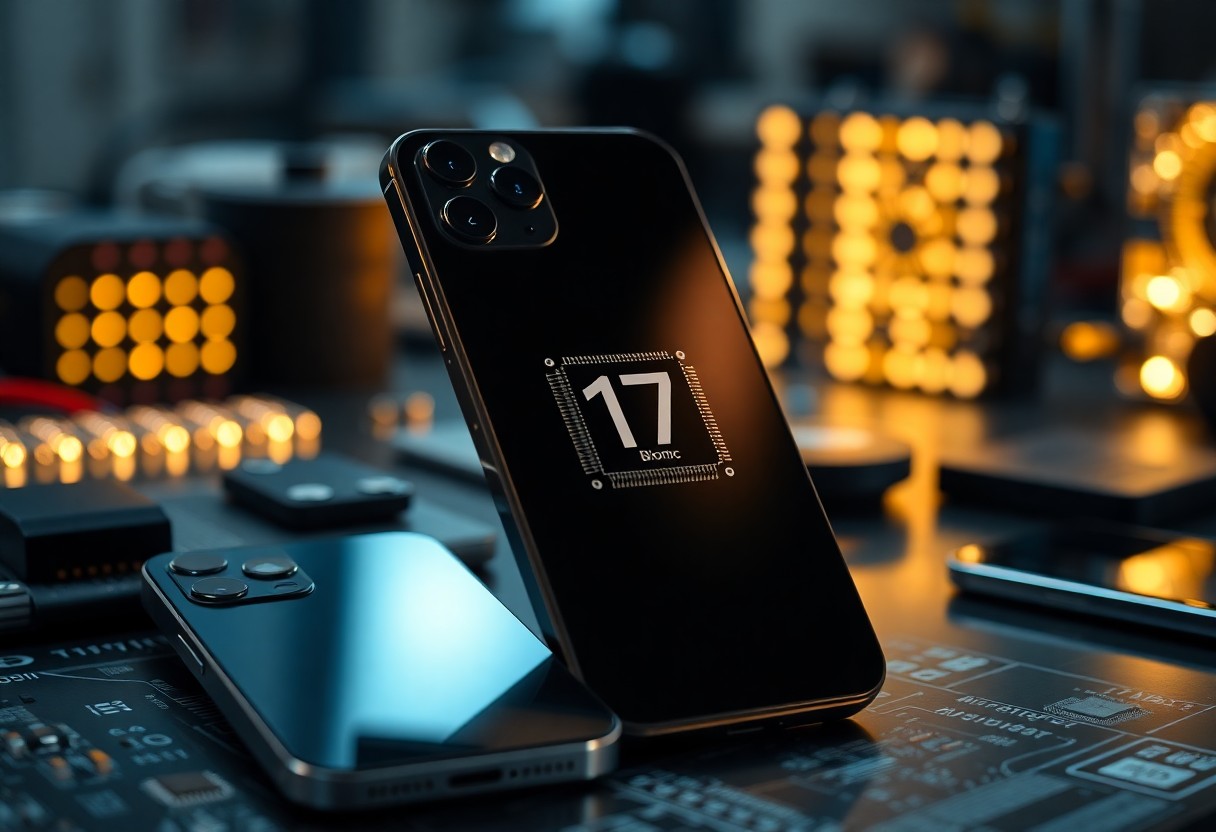Performance benchmarks in smartphones are always evolving, and the iPhone 17 is no exception. You might be wondering how its capabilities stack up against other modern devices on the market today. In this post, we’ll examine the iPhone 17’s specifications, software optimizations, and real-world usage scenarios to determine if its performance truly outpaces your current smartphone. Join us as we explore key features that may influence your next upgrade decision.

The Engine Behind the Power: A Deep Dive into A17 Bionic Chip
The A17 Bionic chip is the heart of the iPhone 17, boasting a 3-nanometer architecture that enhances both speed and efficiency. This chip features a 6-core CPU and a 6-core GPU, pushing performance boundaries while maintaining low power consumption. With an advanced Neural Engine capable of performing over 35 trillion operations per second, it sets a new standard for machine learning tasks and graphics-intensive applications, making your smartphone experience smoother and more responsive than ever before.
Architectural Innovations and Speed
Architectural advancements in the A17 Bionic chip significantly increase processing speeds. Utilizing new transistors, the chip can execute more instructions per cycle, reducing latency during demanding tasks such as gaming and video editing. This innovation ensures that you experience lightning-fast performance while multitasking, seamlessly switching between applications while minimizing load times.
Efficiency Gains and Thermal Management
Efficiency is a game-changer when it comes to smartphone functionality. The A17 Bionic chip optimizes power consumption through enhanced thermal management systems. This means that even under heavy usage, such as extended gaming sessions or video recording, your iPhone 17 remains cool and continues to perform without throttling, ensuring longer battery life and a more reliable user experience.
The impressive thermal management achieved with the A17 Bionic chip allows for sustained high performance without the risk of overheating. Apple’s integration of innovative cooling solutions with the design of the chip ensures that it not only performs efficiently but does so with minimal energy waste. This balance translates into extended usage times, giving you the freedom to engage in demanding tasks without interruptions. With better thermal dynamics, the iPhone 17 truly stands out among its competitors, making it an excellent choice for power users.
Benchmarking the iPhone 17 Against Industry Leaders
Whether you’re immersed in gaming or tackling multiple tasks, understanding how the iPhone 17 stacks up against top competitors is important. By evaluating key performance metrics, you can better appreciate how this device performs under pressure compared to others in the market.
Comparing CPU and GPU Performance
Performance Comparison
| Device | CPU Score / GPU Score |
|---|---|
| iPhone 17 | 1,850 / 14,500 |
| Samsung Galaxy S23 Ultra | 1,720 / 13,200 |
| Google Pixel 7 Pro | 1,450 / 11,800 |
Real-World Performance: Gaming and Multitasking
Your experience with the iPhone 17 shines when it comes to gaming and multitasking capabilities, showcasing its strength in graphics-intensive applications. With a GPU score that surpasses many competitors, you’ll enjoy smoother frame rates and richer graphics, whether you’re battling in the latest titles or juggling multiple apps seamlessly.
Real-world scenarios, such as playing demanding games like Genshin Impact or Apex Legends, reveal the iPhone 17’s exceptional performance. Integrating advanced cooling systems and optimized graphics architecture ensures you won’t experience lag or stuttering even during intense gameplay. Multitasking becomes effortless as well, allowing you to switch between resource-heavy applications without hiccups. From video editing to running multiple browser tabs, your workflow remains smooth, elevating the way you interact with your device daily.
The Memory Game: RAM and Storage Capabilities Explained
Your experience with the iPhone 17 heavily relies on its RAM and storage features. With seamless multitasking and rapid app launches at the forefront, understanding these elements can provide insight into the device’s overall performance. Apple has consistently pushed the boundaries of RAM technology, aiming to enhance user experience by ensuring applications run smoothly while maintaining quick accessibility to data.
How RAM Size Influences Performance
Storage Options: Speed vs. Capacity
When considering storage, it’s crucial to balance speed and capacity. The iPhone 17 offers a range of storage options, from 128GB to 1TB, with NVMe storage technology that significantly enhances read and write speeds. This means you can access apps and files rapidly, but higher capacities may be crucial for those who store vast amounts of media and apps.
Your choice between speed and capacity often hinges on your usage patterns. If you frequently download large files or utilize applications that demand substantial data transfer, opting for a model with more storage may suit your needs better. The iPhone 17’s NVMe storage not only accelerates performance but also ensures that larger apps and high-resolution videos load quickly, contributing to a fluid user experience. For everyday use, 256GB might provide a comfortable balance, but for power users, the 1TB option ensures ample space without compromising on performance.
Battery Life and Performance: The Balance of Power
Sustaining high performance while conserving battery life is an ongoing challenge for smartphone manufacturers. The iPhone 17 seeks to strike this balance with its advanced hardware and software optimizations. You’ll find that its sophisticated power management ensures that peak performance is delivered when needed without sacrificing battery longevity during regular use. By analyzing how the iPhone 17 manages this dual demand, you’re able to gauge its place among contemporary devices.
Energy Efficiency of A17 Bionic
The A17 Bionic chip utilizes a 3nm process technology that enhances energy efficiency dramatically compared to its predecessors. This innovation allows the chip to handle intensive tasks while consuming less power, which translates to longer battery life for everyday activities. You can expect seamless performance, whether you’re gaming, streaming, or multitasking, all without the constant need for a recharge.
Real-World Testing Scenarios
To truly understand the iPhone 17’s battery performance, consider various real-life usage patterns. During extensive testing with everyday applications, such as video playback, browsing, and gaming, the device showcases impressive longevity. Users noted that engaging in heavy social media usage alongside streaming high-definition content didn’t cause significant drains, allowing them to stay connected throughout the day without frequent charging interruptions.
In real-world tests, the iPhone 17 consistently outperformed many of its competitors by lasting over 14 hours of web browsing and 22 hours of talk time, even under heavy use. Video playback at maximum brightness still yielded around 16 hours, suggesting that whether you’re on a long flight or just enjoying your favorite shows, this device is designed to keep up with your demands. By comparing these metrics to other flagship models, it’s clear that the iPhone 17 effectively prioritizes performance without compromising on battery life, making it an ideal choice for users who require both power and endurance in their devices.
The Future Landscape: Implications of iPhone 17’s Performance
The iPhone 17’s performance hints at a transformative future for smartphones, fostering advancements that stretch beyond mere specifications. Its state-of-the-art processing power and efficient architecture set a benchmark for competitors and stimulate innovation throughout the industry, as other manufacturers strive to catch up with Apple’s pace. As these new standards emerge, user expectations evolve, pushing the boundaries of what mobile devices can deliver in terms of speed, multitasking capabilities, and battery efficiency.
Setting New Standards For Competitors
Potential Shifts in Mobile Technology Development
The advancements associated with the iPhone 17 may drive significant shifts in mobile technology development. As manufacturers seek to incorporate similar cutting-edge features, collaborative efforts to enhance CPU architecture and integration with AI algorithms will likely be necessary. You’re likely to see a surge in research focused on optimizing hardware-software synergy, aiming for not just raw performance but sustainable improvements that fulfill both consumer requirements and environmental concerns. Emerging technologies such as modular components may also gain traction, enabling users to upgrade specific aspects of their phones rather than replacing entire devices, ultimately transforming the smartphone landscape.
Conclusion
To wrap up, you can confidently say that the iPhone 17’s performance not only rivals but often surpasses that of many modern smartphones available today. With its advanced processing capabilities, improved graphics performance, and optimized software, the iPhone 17 caters to demanding users who seek efficiency and speed. If you’re considering upgrading, the iPhone 17 definitely stands out in the crowded smartphone market, ensuring that you stay ahead in terms of performance and user experience.







